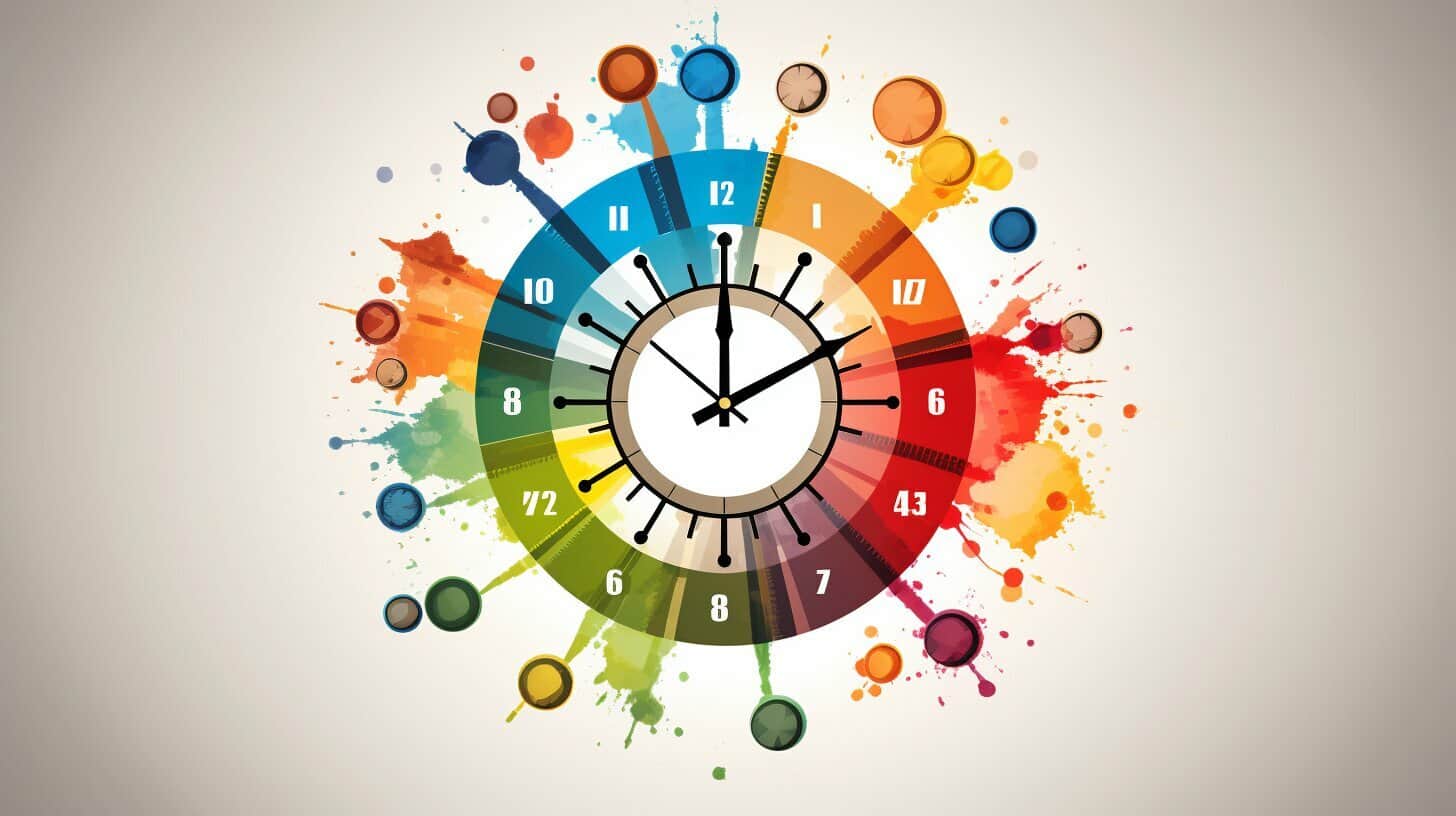As a busy professional, it can be challenging to manage the demands of work and personal life. However, finding a balance between the two is essential for overall well-being and happiness. That’s why I’m excited to celebrate Take Back Your Time Day, a day dedicated to raising awareness for better time management and work-life balance.
Key Takeaways:
- Take Back Your Time Day is a day dedicated to better time management and work-life balance
- Maintaining a healthy balance between work and personal life is essential for overall well-being and happiness
What is Take Back Your Time Day?
Take Back Your Time Day is a global event that takes place on October 24th every year. It was first established in the United States in 2003 by the Take Back Your Time organization, which is dedicated to promoting awareness of the importance of work-life balance and the effects of overwork on individuals and communities.
The purpose of the day is to encourage individuals and organizations to reflect on their work habits and find ways to better manage their time and achieve a healthier work-life balance. It aims to inspire people to prioritize their personal lives and well-being, and to challenge the culture of overwork that is prevalent in many industries and societies.
Take Back Your Time Day is a reminder that time is a precious resource that should be managed wisely, and that our well-being and happiness depend on finding a balance between work and personal life.
Why is Work-Life Balance Important?
Work-life balance is crucial for our overall well-being and happiness. When we prioritize our personal lives in addition to our professional goals, we can achieve a more balanced and fulfilling lifestyle.
Research has shown that those who maintain work-life balance experience increased job satisfaction and productivity. In fact, a study by the American Psychological Association found that employees who feel they have good work-life balance are more likely to feel motivated and committed to their work.
Moreover, maintaining a healthy work-life balance can reduce stress and prevent burnout. When we allow ourselves time for rest, relaxation, and hobbies, we recharge our batteries and return to work feeling refreshed and energized. On the other hand, those who neglect their personal lives and work too much are at risk of experiencing fatigue, exhaustion, and even mental health issues.
In addition to these benefits, there are also long-term advantages to prioritizing work-life balance. By investing in our personal lives, we can develop strong relationships, pursue our passions, and achieve personal growth. We can also cultivate a sense of purpose and fulfillment that extends beyond our professional lives.

Time Management Tips
As a professional copywriting journalist, I’ve learned that effective time management is crucial for maintaining work-life balance. Here are some tips to help you manage your time more efficiently:
- Prioritize Tasks: Make a to-do list and focus on completing the most important tasks first.
- Set Goals: Determine specific goals and timelines for completing them. This can increase motivation and make the task seem more manageable.
- Eliminate Distractions: Turn off notifications on your phone and avoid checking social media or email during work hours to maintain focus and productivity.
In addition to these tips, it’s important to make time for breaks throughout the day. Taking short breaks can increase productivity and reduce stress levels.
Effective time management is not about doing more in less time, but rather focusing on what’s important and using your time wisely.
By implementing these time management tips, you can increase productivity, reduce stress, and achieve a better work-life balance.
Productivity Hacks
As someone who loves to get things done efficiently, I have gathered various productivity hacks throughout the years that have helped me optimize my workflow. Here are some of my favorite tips for maximizing productivity:
1. Eliminate Distractions
When I need to focus on a task, I make sure to turn off all notifications on my phone and computer. I also use noise-cancelling headphones to block out any background noise. This helps me get into a flow state and accomplish more in less time.
2. Use the Pomodoro Technique
This technique involves breaking down work into 25-minute intervals with short breaks in between. By setting a timer for each interval, you can maintain your focus and avoid burnout. After completing a few pomodoros, take a longer break to recharge.
| Pomodoro Technique Steps | Duration |
|---|---|
| Work Interval | 25 minutes |
| Short Break | 5 minutes |
| Long Break | 15-30 minutes |
3. Delegate Tasks
It’s important to recognize when you’re taking on too much and learn to delegate tasks to others. This can free up your time to focus on high-priority tasks that require your unique skills and expertise.
4. Prioritize Your Tasks
I like to make a to-do list each day and prioritize my tasks based on urgency and importance. This ensures that I’m tackling the most crucial tasks first and not wasting time on less important ones.
5. Move Your Body
Regular exercise can boost productivity by improving focus and reducing stress. I try to incorporate physical activity into my daily routine, whether that’s taking a walk during my lunch break or doing a quick yoga session before work.
6. Use Keyboard Shortcuts
Learning keyboard shortcuts for commonly used tasks can save you a lot of time in the long run. For example, instead of using your mouse to copy and paste, you can use the keyboard shortcuts Ctrl+C and Ctrl+V.
By implementing these productivity hacks, you can work smarter, not harder, and achieve more with your time.

Stress Reduction Techniques
Managing stress is crucial for achieving work-life balance. Here are some effective stress reduction techniques:
- Practice mindfulness: Mindfulness involves being present in the moment and focusing on your thoughts and sensations. This can help reduce stress and improve overall well-being. Try deep breathing exercises or meditation to practice mindfulness.
- Spend time in nature: Spending time in nature can help reduce stress and improve mood. Take a walk in the park or go for a hike to enjoy the outdoors.
- Exercise: Exercise is a great way to reduce stress and improve physical health. Try incorporating a daily workout routine into your schedule, whether it be running, yoga, or weightlifting.
- Practice self-care: Taking time for yourself and engaging in activities you enjoy can help reduce stress. Whether it be reading a book, taking a bubble bath, or watching your favorite TV show, make sure to prioritize self-care.
- Connect with others: Talking to friends and family, or even seeking support from a therapist or counselor, can help reduce stress and improve overall mental health. Don’t be afraid to reach out for help when needed.
“Stress is not what happens to us. It’s our response to what happens. And response is something we can choose.”
– Maureen Killoran
Effective Time Management Strategies
In order to manage my time effectively, I always start by determining my top priorities. I make a list of tasks and categorize them based on their importance and urgency. This helps me focus on the most critical tasks first.
Another strategy I use is setting boundaries. I determine my work schedule and stick to it to ensure I don’t overwork myself. I also make sure not to get distracted by non-work-related activities during my work hours.
Avoiding Procrastination
Procrastination is a significant time-waster. To avoid procrastination, I break down tasks into smaller, more manageable tasks. This makes it easier to tackle them without feeling overwhelmed.
I also use the Pomodoro technique, which involves working for 25 minutes and taking a short break, to keep my motivation high. This helps me stay focused and productive throughout the day.
Prioritization and Saying No
Effective time management requires prioritization and knowing when to say no. When I have too many tasks on my plate, I evaluate each task’s urgency and importance and decide which ones to focus on first. I also make sure to say no to tasks that are not important or don’t align with my goals and values.
By prioritizing my tasks, setting boundaries, avoiding procrastination, and knowing when to say no, I can manage my time effectively and achieve a healthier work-life balance.

Time-Saving Techniques
Time is your most valuable resource – and it’s finite. That’s why it’s important to employ time-saving techniques to maximize your productivity. Here are some strategies to help:
| Technique | Description |
|---|---|
| Batching | Grouping similar tasks together and completing them all at once, instead of switching back and forth between tasks. |
| Outsourcing/Delegation | Identifying tasks that can be completed by someone else and delegating them to free up your time. |
| Automation | Utilizing technology to automate repetitive tasks, such as email templates or scheduling software. |
| Prioritization | Focusing on tasks with the highest priority and urgency, rather than spending time on less important tasks. |
By utilizing these time-saving techniques, you can optimize your workflow and free up more time for the things that matter most.
Time Management Tools
Effective time management requires the use of appropriate tools and technologies to increase productivity and streamline tasks. Below are some of the best time management tools available:
| Tool | Description |
|---|---|
| Asana | A project management tool that helps organize and delegate tasks, set deadlines, and track progress. |
| Trello | A visual collaboration tool that organizes projects into boards, allowing users to see what’s being worked on and by whom. |
| Google Calendar | An online calendar that keeps track of appointments, meetings, and events, which can be shared with others for scheduling purposes. |
| RescueTime | A time-tracking tool that monitors time spent on different applications and websites, providing insights into productivity habits and areas for improvement. |
| Pomodoro Timer | A technique that helps users break down work into 25-minute intervals, known as “pomodoros,” followed by short breaks to promote sustained focus. |
By incorporating these tools into your daily routine, you can better manage your time and increase your productivity.

Prioritization Methods
One of the most important aspects of effective time management is prioritizing tasks and responsibilities. Here are some methods for prioritization:
- Urgency-Importance Matrix: This method involves evaluating tasks based on their level of urgency and importance. Tasks that are both urgent and important should be prioritized first, followed by important but non-urgent tasks.
- Eisenhower Matrix: Similar to the urgency-importance matrix, the Eisenhower Matrix categorizes tasks as urgent, important, both, or neither. This method emphasizes the need to delegate or eliminate tasks that are not important or urgent.
- ABC Method: Tasks are categorized as A, B, or C based on their level of importance. A tasks are high priority, B tasks are medium priority, and C tasks are low priority.
- SMART Goals: Setting goals that are specific, measurable, achievable, relevant, and time-bound can help individuals prioritize their tasks based on their alignment with these goals.
Regardless of the prioritization method used, it’s important to regularly evaluate and adjust priorities as needed. Learning to say no to tasks that don’t align with personal or professional goals can also help prioritize time and maintain a healthy work-life balance.

Time Management Skills for a Happier Life
Proper time management skills are not just about being productive or efficient. They can also be a key factor in achieving a happier life. By balancing work and personal time, we can prioritize the things that matter most to us, whether it’s spending time with loved ones, pursuing hobbies or interests, or simply practicing self-care.
Effective time management skills can also lead to reduced stress levels, better mental health, and improved relationships. When we feel in control of our time and our lives, we can approach challenges with a more positive attitude and feel more fulfilled in our personal and professional lives.
Prioritization Techniques
One of the most important time management skills for achieving a happier life is learning how to prioritize tasks effectively. By using techniques such as the Eisenhower Matrix, we can evaluate tasks based on their urgency and importance, and focus on those that align with our long-term goals and values.
It’s also important to learn when to say no and set boundaries. By being selective about the tasks we take on and setting realistic expectations for ourselves and others, we can avoid overloading our schedules and feeling overwhelmed.
Focus and Concentration
Another key aspect of time management for a happier life is improving our ability to focus and concentrate. By minimizing distractions such as social media and email notifications, we can stay more focused on the task at hand and get things done more efficiently.
It’s also important to take breaks and practice self-care to avoid burnout and maintain our focus over the long term. Activities such as meditation, exercise, and spending time in nature can help us recharge and stay energized.
Time Management and Relationships
Finally, effective time management skills can also have a positive impact on our relationships. By prioritizing time with loved ones and making time for meaningful interactions, we can strengthen our connections and feel more fulfilled in our personal lives.
It’s also important to set aside time for ourselves and pursue our own interests and hobbies. By taking care of our own needs and pursuing our own passions, we can approach our relationships with a more positive and balanced mindset.
Ultimately, effective time management is about finding a balance between our personal and professional lives, and prioritizing the things that matter most to us. By implementing practical time management skills and techniques, we can achieve a happier, more fulfilling life.
Conclusion on Take Back Your Time Day
Take Back Your Time Day serves as a reminder of the importance of work-life balance. By prioritizing our time effectively, we can improve our productivity, reduce stress, and ultimately lead happier lives.
Throughout this article, we have explored various strategies and techniques for effective time management, from prioritization methods to time-saving techniques and stress reduction tips. By implementing these strategies, we can reclaim our time and achieve a better work-life balance.
Remember, achieving a healthy balance between work and personal life is crucial for overall well-being and happiness. So, on this Take Back Your Time Day, let’s prioritize our time and commit to living a healthier and more fulfilling lifestyle.
FAQ on Take Back Your Time Day
Q: What is Take Back Your Time Day?
A: Take Back Your Time Day is an annual event that promotes the importance of work-life balance and better time management. It is a day dedicated to raising awareness about the need to reclaim our time and find a healthy balance between work and personal life.
Q: Why is Work-Life Balance Important?
A: Work-life balance is crucial for overall well-being and happiness. It allows individuals to have time for themselves, their relationships, and their hobbies, which leads to reduced stress, increased productivity, and better overall quality of life.
Q: What are some Time Management Tips?
A: Here are some practical time management tips: prioritize tasks, set goals, create a schedule, eliminate distractions, delegate when possible, and take breaks to recharge. These strategies can help you manage your time more efficiently and achieve a better work-life balance.
Q: What are some Productivity Hacks?
A: To boost productivity, try eliminating distractions such as turning off notifications, breaking tasks into smaller, manageable chunks, using productivity apps or tools, and establishing daily routines. These hacks can help you optimize your workflow and get more done in less time.
Q: What are some Stress Reduction Techniques?
A: To manage stress, practice relaxation techniques like deep breathing exercises or meditation, prioritize self-care, maintain a healthy work-life balance, and engage in activities that bring you joy. Taking care of your mental and emotional well-being is crucial for achieving work-life balance.
Q: What are some Effective Time Management Strategies?
A: Effective time management strategies include prioritizing tasks, setting boundaries, avoiding procrastination, and breaking big tasks into smaller, manageable steps. By implementing these strategies, you can make the most of your time and achieve better work-life balance.
Q: What are some Time-Saving Techniques?
A: Time-saving techniques involve automating repetitive tasks, delegating responsibilities, using time-tracking apps, and optimizing your workflow. These techniques can help you save valuable time and increase your efficiency, allowing you to have more time for the things that matter most.
Q: What are some Time Management Tools?
A: There are various time management tools available, such as productivity apps, task management software, and calendar systems. These tools can help you organize your tasks, set reminders, and manage your time effectively, enhancing your work-life balance.
Q: What are some Prioritization Methods?
A: Prioritization methods include evaluating urgency and importance, aligning tasks with long-term goals, and learning to say no when necessary. By effectively prioritizing your tasks, you can focus on what matters most and maintain a better work-life balance.
Q: How do Time Management Skills contribute to a Happier Life?
A: Effective time management skills lead to a happier life by allowing individuals to allocate time for personal growth, relationships, and self-care. When you manage your time well, you experience less stress and have more time for activities that bring you joy, leading to greater overall satisfaction.





Leave a Reply